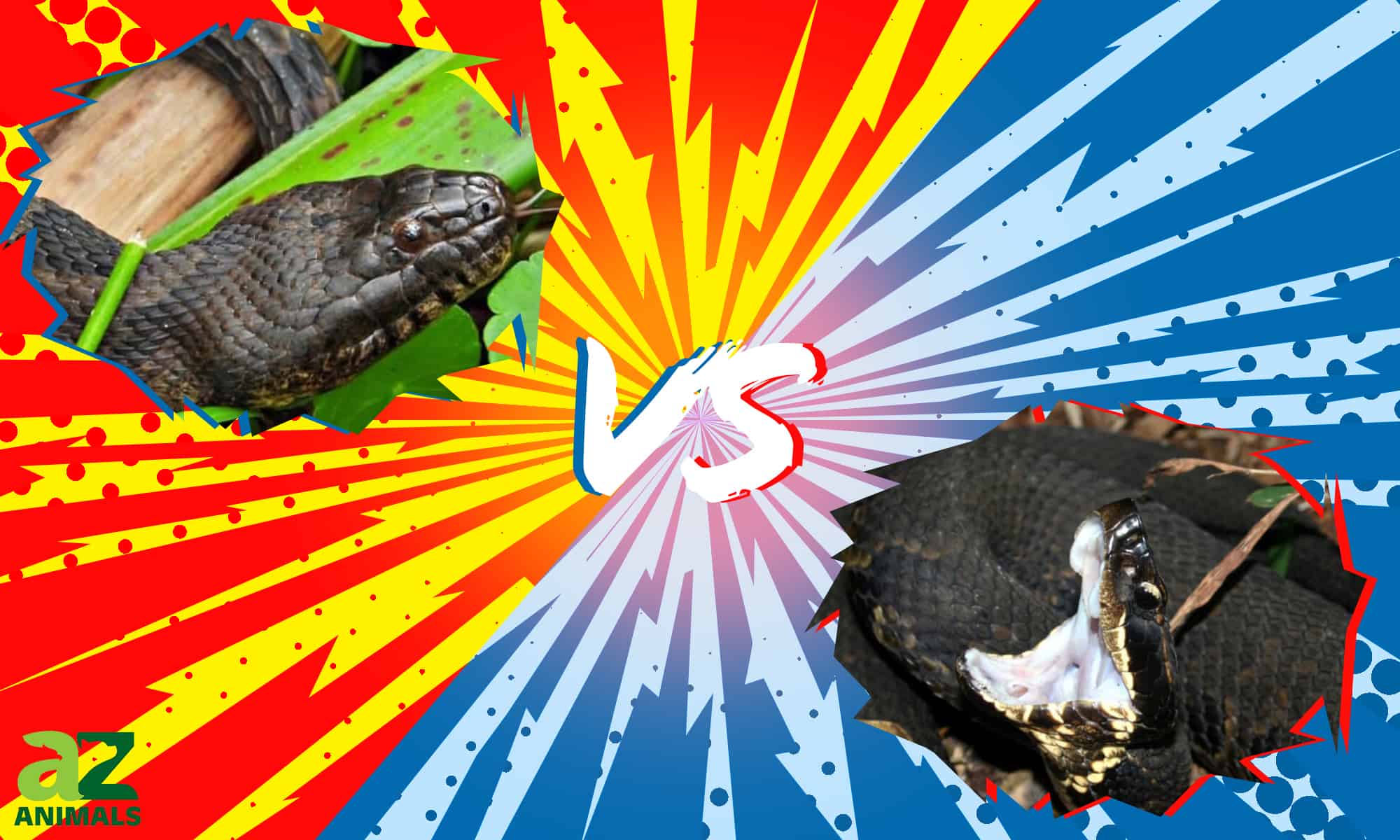There are many species of snake in the United States, but in the southeastern part of the country, two of these species stand out. These are the brown watersnake and the infamous cottonmouth. The two are very different species, yet they’re often confused for one another.
Here, we’ll learn exactly how to tell the difference between the two. Given that only one has a venomous bite, it’s important to know which is which. So join us as we discover all of the differences between brown watersnakes and cottonmouths. We’ll go over the appearance, preferred habitat, behavior, diet, and relative danger of each species.
Comparing Brown Watersnakes and Cottonmouths

Cottonmouth snakes are highly venomous, and people often kill them on sight. Sadly, brown watersnakes are often mistaken for cottonmouths and also killed. In the end, no matter what species of snake you’re looking at, it’s important to remember that it’s an important part of the native ecosystem and should be left alone.
There are a few big differences between brown watersnakes and water moccasins, but there are also similarities. Check out the table below to learn more.
| Brown Watersnake | Cottonmouth | |
| Size | Length – 3.5 to 6 feet | Length – 2 to 6 feet |
| Color | Brown | Brown, black, olive |
| Body Type | Slender body with a relatively long, thin tail | Arrow-shaped head, nearly triangular when viewed from the top |
| Temperament | Aggressive when provoked | Aggressive when provoked |
| Lifespan | Up to 9 years in captivity | 15 – 20 years |
Key Differences Between Brown Watersnakes and Cottonmouths
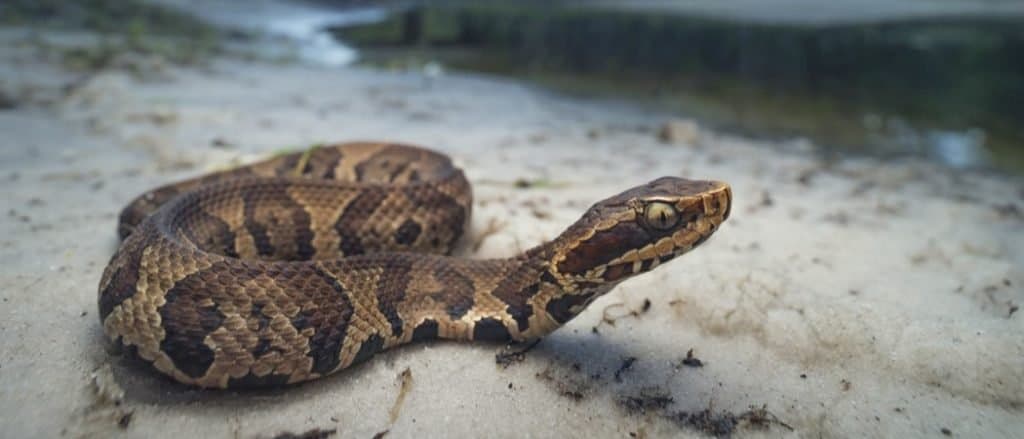
Cottonmouths have arrow-shaped heads.
©Kristian Bell/Shutterstock.com
The key differences between brown watersnakes and cottonmouths are appearance, preferred habitat, behavior, diet, and relative danger of each species.
We will discuss all of these differences in more detail below.
Brown Watersnake Vs Cottonmouth: Appearance
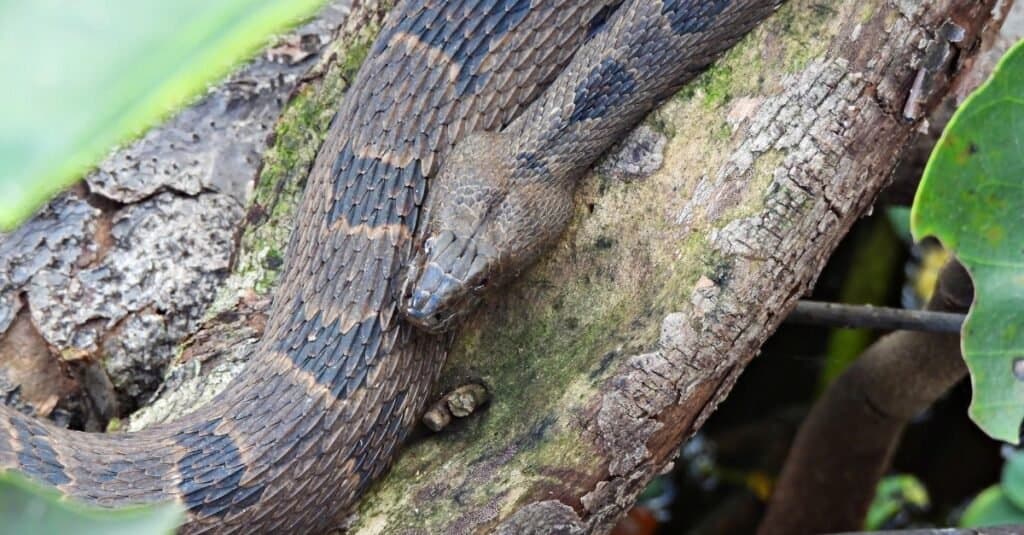
Adult brown watersnakes range from yellow-brown to dark brown in color.
©iStock.com/passion4nature
Brown watersnakes and cottonmouths, also known as water moccasins, are almost the same size. The biggest difference in size between the two is that, in cottonmouths, males are bigger than females. On the other hand, brown-banded watersnake males are much smaller than females.
Cottonmouths range in color from yellow-brown to red-brown, with older snakes tending to be darker in color. They have darker brown stripes encircling the lengths of their bodies. And, of course, cottonmouth snakes’ mouths are bright white on the inside. In contrast, brown watersnakes do not have stripes, though they share the same yellow-brown color of many cottonmouths. Brown watersnakes also don’t have lightly colored mouth interiors, and they don’t come in almost solid-colored variations like some cottonmouths do.
Brown Watersnake Vs Cottonmouth: Habitat
Both cottonmouths and brown watersnakes are endemic to the coastal states of the southeast, including Florida, Georgia, South Carolina, and North Carolina. Brown watersnakes live along the coast and lowlands, while cottonmouths live farther west along floodplains and sources of fresh water.
Brown watersnakes, like water moccasins, are semi-aquatic snakes. They rely on permanent water sources, like lakes and rivers, and are almost never found around impermanent sources of water, like floodplains.
Cottonmouths, on the other hand, will live anywhere there is water, even if that water is temporary. Brown watersnakes prefer flowing water like canals, cypress creeks, and rivers. Additionally, cottonmouths don’t climb more than a few feet high in trees, while brown watersnakes have been known to climb up to twenty feet up in trees overhanging rivers.
Brown Watersnake Vs Cottonmouth: Behavior
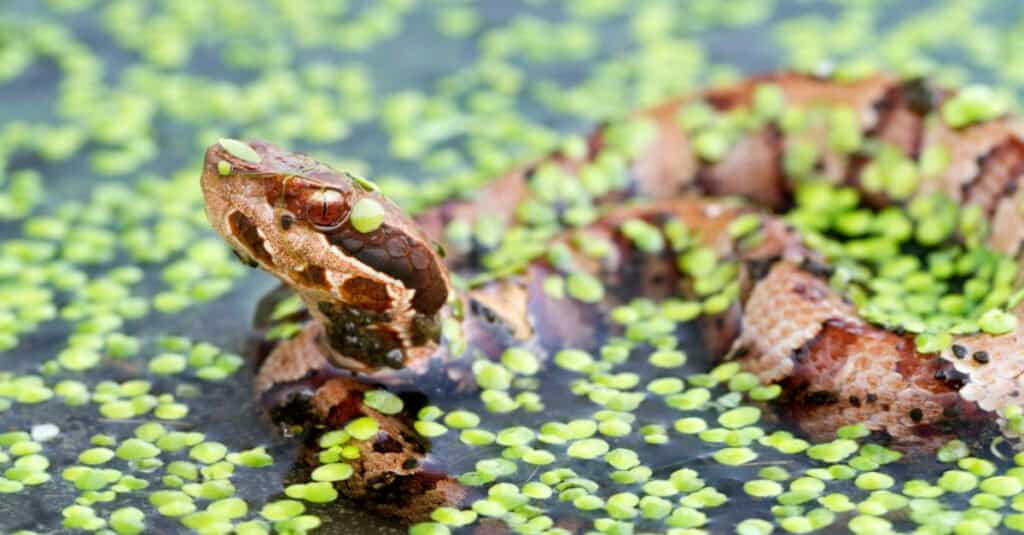
Cottonmouths are good swimmers; they hunt both on land and in water.
©Mark_Kostich/Shutterstock.com
While cottonmouths birth only 1-20 snakelings every 2-3 years, brown watersnakes birth between 20-60 snakelings at a time. Both species are active during the day and at night; they hunt whenever they can. Neither species is particularly aggressive, though brown watersnakes are known to deliver painful bites if humans get too close. Unfortunately, this happens all too often as brown watersnakes have a habit of falling into boats and canoes as they pass below on rivers.
Unlike cottonmouths, brown watersnakes have no brightly colored mouth interior. Cottonmouths often open their mouths and hold their ground in defense; brown watersnakes would much rather flee or hide than stand and fight.
Brown Watersnake Vs Cottonmouth Lifespan
While watersnakes like the brown watersnake typically live to about 9 years or more in captivity, the cottonmouth can survive twice as long, with an average lifespan of 20-25 years. In the wild, both types of snakes can have threats, especially as a baby or juvenile snakes, from predators, though the types of predators vary. Young cottonmouths can be preyed on by eagles, egrets, raccoons, longnose gars, largemouth bass, and snapping turtles. Whereas animals that prey on watersnakes include raccoons, skunks, foxes, and larger snakes like milk snakes and racers.
Brown Watersnake Vs Cottonmouth: Diet
While both brown watersnakes and cottonmouths are common along water sources, only the brown watersnakes eat primarily fish. They’re both long, heavy snakes, but cottonmouths have a more varied diet than brown watersnakes. Both species are excellent swimmers, though brown watersnakes are much more likely to hunt along the edges of running water. They will even hunt along river bottoms. Because brown watersnakes feed almost exclusively on fish, like small catfish, they are found primarily around permanent sources of water.
Cottonmouths, on the other hand, will eat just about anything they can get their mouths around. Both species employ ambush and active foraging hunting strategies, though cottonmouths are much more likely to hunt both on land and in water. Cottonmouths eat everything from fish to baby alligators; their diet includes amphibians, small rodents, crayfish, turtles, and smaller snakes as well.
Brown Watersnake Vs Cottonmouth: Venom
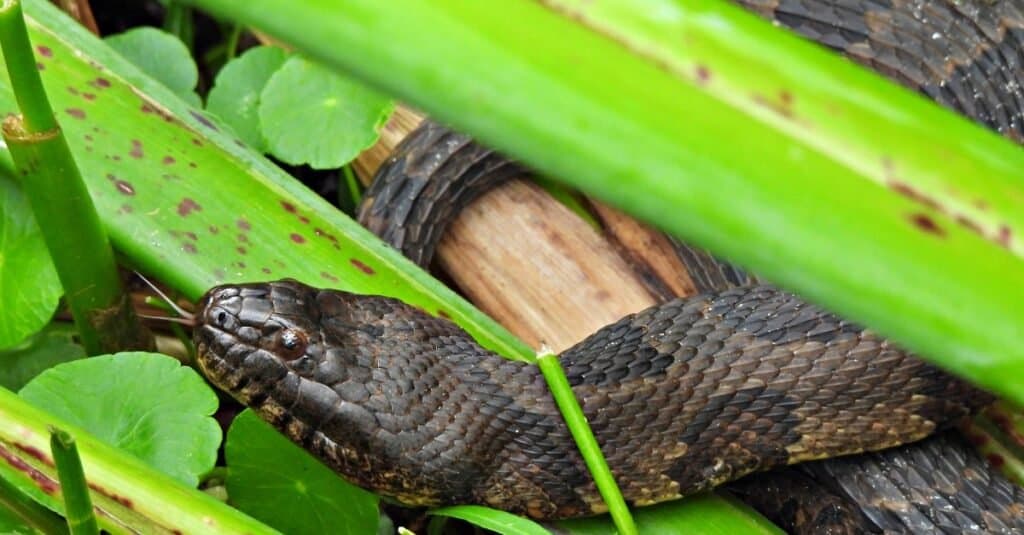
Brown watersnakes are not venomous, though they will bite to defend themselves.
©iStock.com/passion4nature
Cottonmouths and brown watersnakes have very similar appearances, though only one of them poses any real threat to humans. While brown watersnakes are completely venomless, cottonmouths possess hemotoxic venom, which they inject using hollow, hypodermic needle-like fangs. Cottonmouths are pit vipers; they have the same kind of venom as copperheads and rattlesnakes. Like rattlesnakes, cottonmouths have two long, recurved fangs at the front of their mouth. These fangs are connected to venom glands located just below the eyes on either side of the skull.
Cottonmouth venom is rather potent- moreso than copperheads but less than rattlesnakes. The venom destroys tissue, causing pain and swelling. Cottonmouth bites sometimes result in permanent scars, and very rarely amputation or death.
Unfortunately, brown watersnakes are often killed by people who mistake them for the venomous cottonmouth. But, cottonmouths, though venomous, pose little threat to humans. In fact, they’re highly unlikely to bite, and even then, they may not inject venom. The exceptions to this rule come when people either step on them or purposely handle them, resulting in a bite.
Which Snake is More Dangerous?

When cottonmouths bite, their venom acts to pre-digest the flesh surrounding the bite and to begin shutting down the organs and inducing paralysis in the victim. Brown watersnakes, on the other hand, have no venom and can do more than bruise and puncture with their bite. Only one species can send a human to the hospital, and that’s the cottonmouth.
If a cottonmouth bites you, it’s important to move away from the snake rather than try to capture or injure it—this will likely result in additional bites. Once you’re a safe distance away, call 911, and get to a hospital as soon as possible. Cottonmouth bites rarely result in death or serious complications, but avoiding medical care greatly increases your chances of complications. Do not ice the bite, try to suck out the venom, or make cuts over the puncture wounds. Instead, keep the bite below heart level, keep your heart rate low, and get to a hospital.
Up Next…
Keep reading! We think you’ll like these other pages about snakes and other amazing animals.
- New Study: Giant, Flying Spiders to Invade North Toward D.C. and New York
- Kingsnake Vs Cottonmouth: What are the Differences & Which is More Dangerous?
- 96 Snakes Found In Texas (14 are Venomous!)
- Ball Python Morphs: Discover The 50+ Types Of Ball Python Breeds
- Black Racer Snake Vs Cottonmouth
- The Timber Rattlesnake: North America’s Unknown Rattler
Discover the "Monster" Snake 5X Bigger than an Anaconda
Every day A-Z Animals sends out some of the most incredible facts in the world from our free newsletter. Want to discover the 10 most beautiful snakes in the world, a "snake island" where you're never more than 3 feet from danger, or a "monster" snake 5X larger than an anaconda? Then sign up right now and you'll start receiving our daily newsletter absolutely free.
Thank you for reading! Have some feedback for us? Contact the AZ Animals editorial team.

